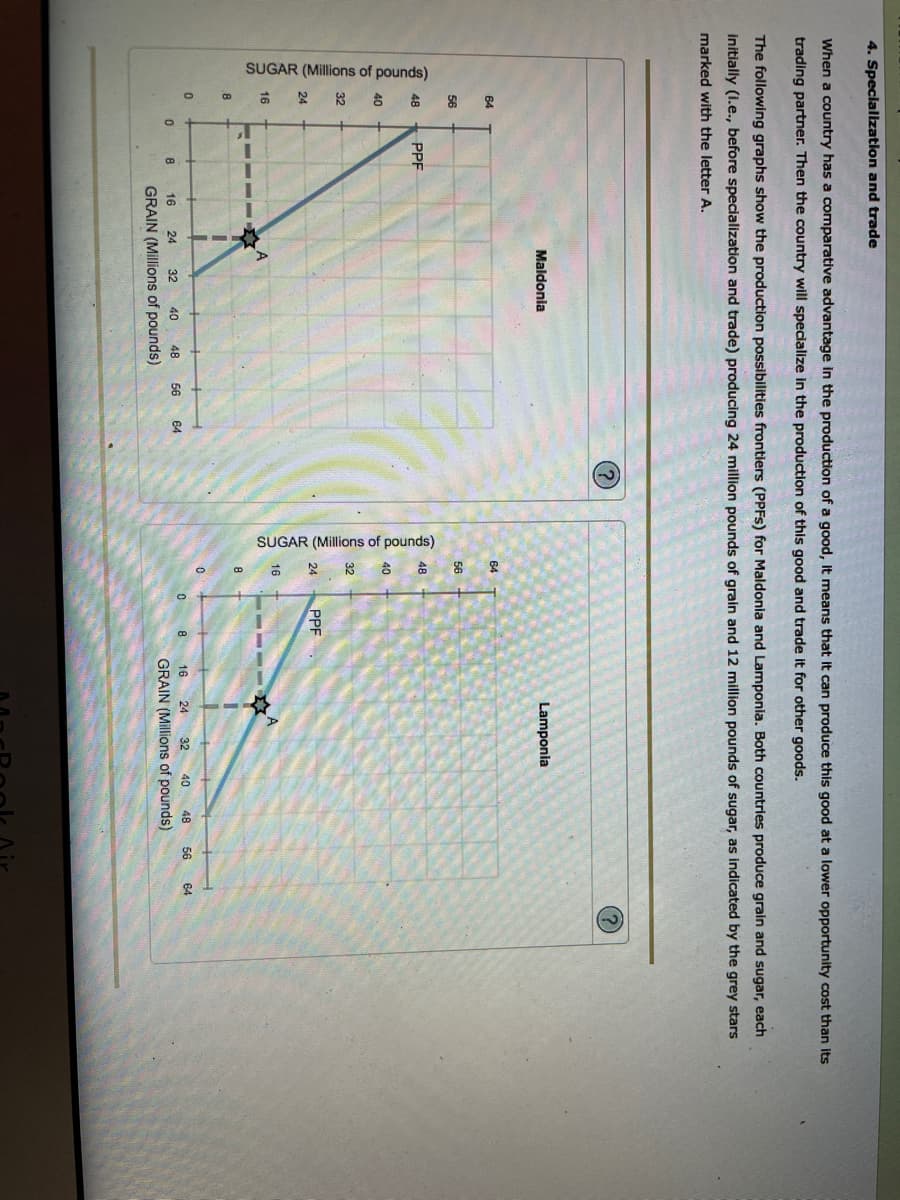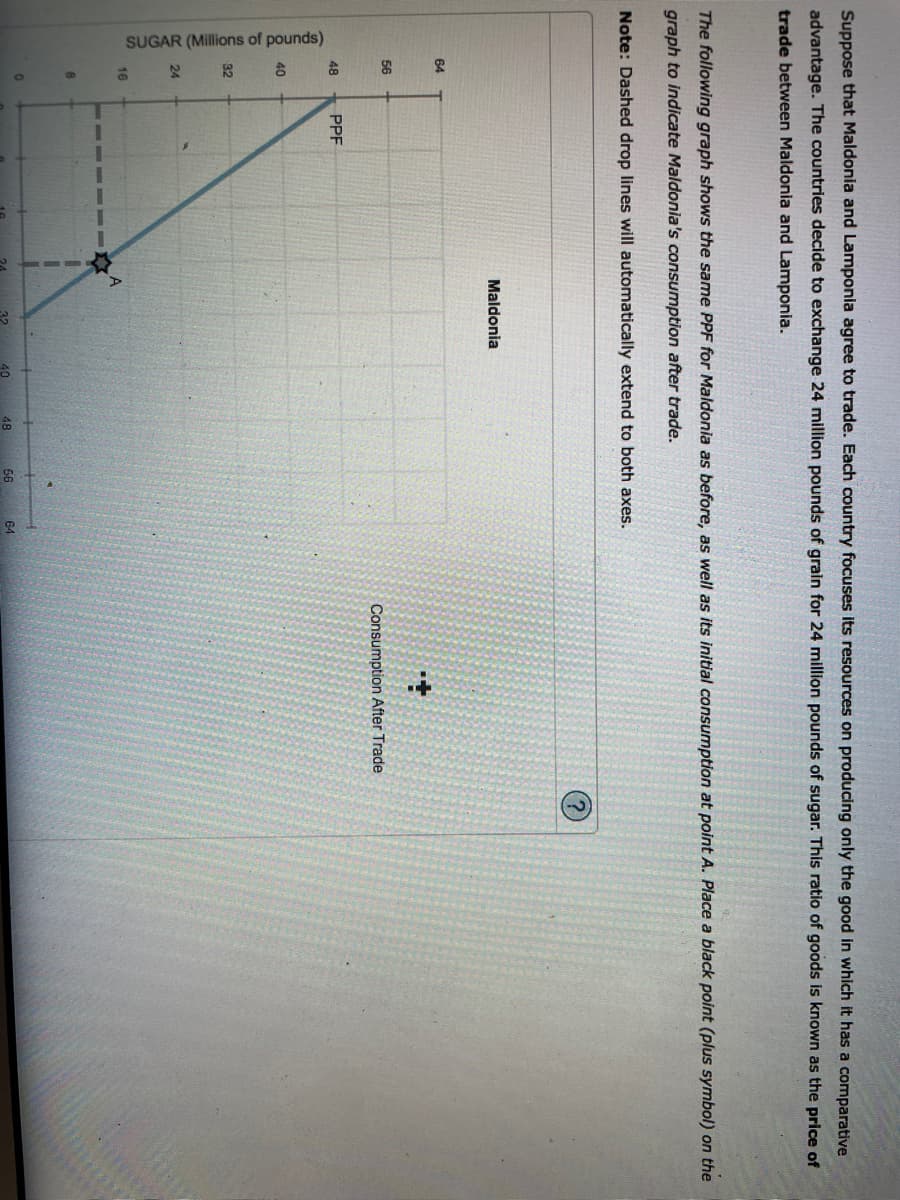SUGAR (Millions of pounds) Suppose that Maldonia and Lamponia agree to trade. Each country focuses its resources on producing only the good in which it has a comparative advantage. The countries decide to exchange 24 million pounds of grain for 24 million pounds of sugar. This ratio of goods is known as the price of trade between Maldonia and Lamponia. The following graph shows the same PPF for Maldonia as before, as well as its initial consumption at point A. Place a black point (plus symbol) on thes graph to indicate Maldonia's consumption after trade. Note: Dashed drop lines will automatically extend to both axes. Maldonia 64 56 Consumption After Trade 48 PPF 40 32 24 16
SUGAR (Millions of pounds) Suppose that Maldonia and Lamponia agree to trade. Each country focuses its resources on producing only the good in which it has a comparative advantage. The countries decide to exchange 24 million pounds of grain for 24 million pounds of sugar. This ratio of goods is known as the price of trade between Maldonia and Lamponia. The following graph shows the same PPF for Maldonia as before, as well as its initial consumption at point A. Place a black point (plus symbol) on thes graph to indicate Maldonia's consumption after trade. Note: Dashed drop lines will automatically extend to both axes. Maldonia 64 56 Consumption After Trade 48 PPF 40 32 24 16
Chapter19: International Trade
Section: Chapter Questions
Problem 1.3P
Related questions
Question

Transcribed Image Text:SUGAR (Millions of pounds)
SUGAR (Millions of pounds)
4. Specialization and trade
When a country has a comparative advantage in the production of a good, it means that it can produce this good at a lower opportunity cost than its
trading partner. Then the country will specialize in the production of this good and trade it for other goods.
The following graphs show the production possibilities frontiers (PPFS) for Maldonia and Lamponia. Both countries produce grain and sugar, each
initially (1.e., before specialization and trade) producing 24 million pounds of grain and 12 million pounds of sugar, as indicated by the grey stars
marked with the letter A.
Maldonia
Lamponia
64
64
56
56
48
PPF
48
40
40
32
32
24
PPF
24
16
16
8
48
56
64
16
24 32
40
48
56
64
16
24
32
40
GRAIN (Millions of pounds)
GRAIN (Millions of pounds)

Transcribed Image Text:SUGAR (Millions of pounds)
Suppose that Maldonia and Lamponia agree to trade. Each country focuses its resources on producing only the good in which it has a comparative
advantage. The countries decide to exchange 24 million pounds of grain for 24 million pounds of sugar. This ratio of goods is known as the price of
trade between Maldonia and Lamponia.
The following graph shows the same PPF for Maldonia as before, as well as its initial consumption at point A. Place a black point (plus symbol) on the
graph to indicate Maldonia's consumption after trade.
Note: Dashed drop lines will automatically extend to both axes.
Maldonia
64
56
Consumption After Trade
48
PPF
40
32
24
16
01
56
64
Expert Solution
This question has been solved!
Explore an expertly crafted, step-by-step solution for a thorough understanding of key concepts.
This is a popular solution!
Trending now
This is a popular solution!
Step by step
Solved in 2 steps with 2 images

Knowledge Booster
Learn more about
Need a deep-dive on the concept behind this application? Look no further. Learn more about this topic, economics and related others by exploring similar questions and additional content below.Recommended textbooks for you



Principles of Macroeconomics (MindTap Course List)
Economics
ISBN:
9781285165912
Author:
N. Gregory Mankiw
Publisher:
Cengage Learning



Principles of Macroeconomics (MindTap Course List)
Economics
ISBN:
9781285165912
Author:
N. Gregory Mankiw
Publisher:
Cengage Learning

Principles of Economics, 7th Edition (MindTap Cou…
Economics
ISBN:
9781285165875
Author:
N. Gregory Mankiw
Publisher:
Cengage Learning

Principles of Microeconomics (MindTap Course List)
Economics
ISBN:
9781305971493
Author:
N. Gregory Mankiw
Publisher:
Cengage Learning

Principles of Economics (MindTap Course List)
Economics
ISBN:
9781305585126
Author:
N. Gregory Mankiw
Publisher:
Cengage Learning